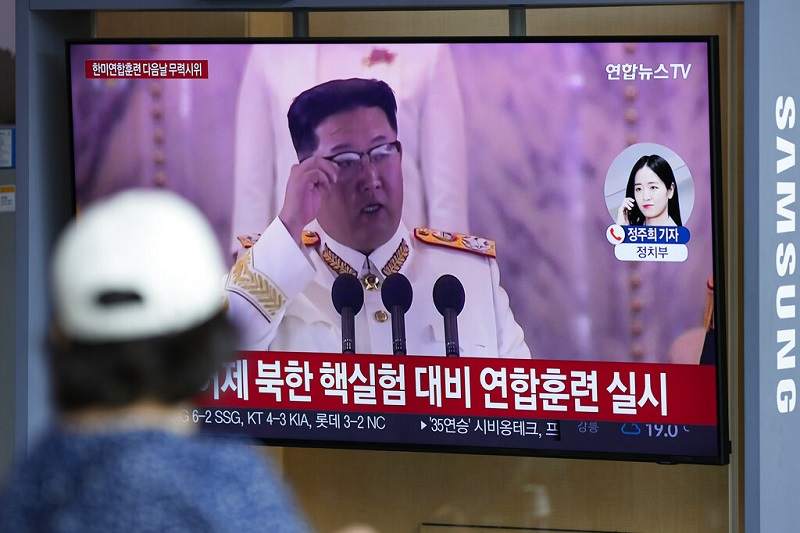N. Korea demonstrates capability to fire missiles in succession from multiple sites

A woman watches a TV screen showing a news program reporting about North Korea’s missile launch with a file footage of North Korean leader Kim Jong Un, at a train station in Seoul on Sunday
1:09 JST, June 7, 2022
SEOUL/WASHINGTON — Pyongyang’s latest launch of eight short-range ballistic missiles has set a single-day record for North Korea, exceeding the seven missiles in a day in 2006 and 2009.
The unprecedented armed provocation from multiple locations toward the Sea of Japan was apparently aimed at demonstrating the progress made in its strike capability, which aims to slip past the missile defense networks of Japan, the United States and South Korea.
According to the South Korean military’s Joint Chiefs of Staff, North Korea appeared to have launched a total of eight missiles over 35 minutes, starting at around 9:08 Sunday morning, with two missiles each fired from four different locations in the country in succession.
North Korea has increased its test-firing of missiles since last September. In most cases it had launched two projectiles in a day when test-firing short-range missiles.
Firing multiple missiles toward targets almost simultaneously is known as a saturation attack, making it more difficult for Japan, the United States and South Korea to jointly intercept them.
Besides this, North Korea in its recent missile launches used not only transporter-erector-launchers (TELs), but also trains exclusively to transport and launch missiles. In addition to gaining saturation attack capability, the country apparently aims at enhancing its mobility to launch surprise missile attacks, thus making it difficult for the United States and South Korea to use preemptive strikes on launch sites in North Korea.
The eight missiles launched on Sunday also included at least one flying on an irregular trajectory, which makes it hard to intercept. Placed on the highest alert among military experts in many countries is what North Korea calls a “new-type tactical guided weapon.” North Korean leader Kim Jong Un suggested in April that this missile was designed to carry tactical nuclear weapons.
A prevailing view among experts has it that North Korea, having in mind U.S. bases in Japan and South Korea, is trying to gain strike capability for an attack by combining saturation attacks, surprise attacks and firing missiles on irregular trajectories.
Upset by U.S.-ROK joint drill?
North Korea test-fired 23 missiles on 15 separate occasions in 2016. It also launched a ballistic missile flying on a lofted trajectory, at a higher altitude than conventional ballistic missiles. In 2017, the country for the first time test-fired its Hwasong 15 (Mars 15), an intercontinental ballistic missile that is theoretically capable of reaching all of the U.S. mainland.
In 2018, Pyongyang declared that it was suspending its nuclear tests and test-firing of ICBMs, and no missiles were launched that year. But as the summit between Kim and then U.S. President Donald Trump ended in failure in February 2019, Pyongyang resumed its armed provocations.
In South Korea, President Yoon Suk-yeol’s conservative administration was inaugurated on May 10, giving a push to the strengthening of cooperation among Seoul, Tokyo and Washington. In light of this, Pyongyang has made its provocative attitude clearer.
The missile launches on Sunday may have been North Korea’s way to show its displeasure at a U.S.-South Korea naval drill conducted June 2-4 in waters southeast off Okinawa, with the participation of a U.S. aircraft carrier.
On May 25, North Korea test-fired an ICBM shortly before U.S. President Joe Biden was to depart for Washington aboard Air Force One as he wrapped up his visits to South Korea and Japan.
The U.S. Indo-Pacific Command, in its statement issued on the heels of the missile launches by North Korea on Sunday, reemphasized, “The U.S. commitment to the defense of the Republic of Korea and Japan remains ironclad.”
Promoting North Korea’s blatant armed provocation is the presence of China and Russia. On May 26, a U.N. Security Council resolution that would have imposed additional sanctions on Pyongyang over its latest ballistic missile tests on May 25 was vetoed by China and Russia. North Korea undoubtedly sees that there won’t be any further sanctions imposed by the UNSC over its missile launches.
The Kim regime is scheduled to hold a key plenary meeting of the Central Committee of the Workers’ Party of Korea this month. Speculation has it that the regime may further escalate provocative acts while also clamping down domestically as the novel coronavirus has been spreading. Another focus of attention is whether North Korea dares to conduct a seventh nuclear test, which its backer China opposes.
"Politics" POPULAR ARTICLE
-

Japan to Support Central Asian Logistics Route That Bypasses Russia, Plan to Be Part of Upcoming Summit in Tokyo
-

Japan to Tighten Screening of Foreigners’ Residential Status by Providing Information of Nonpayment of Taxes
-

Chinese, Russian Bombers Flew Unusual Path by Heading Toward Tokyo; Move Likely Meant to Intimidate Japan
-

Japan Plans National Database to Track Foreign Ownership of Real Estate, Land as It Weighs New Rules
-

Up to 199,000 Deaths Estimated From Mega-Tsunami; Most Recent Occurrence Took Place in 17th Century
JN ACCESS RANKING
-

Tokyo Economic Security Forum to Hold Inaugural Meeting Amid Tense Global Environment
-

Keidanren Chairman Yoshinobu Tsutsui Visits Kashiwazaki-Kariwa Nuclear Power Plant; Inspects New Emergency Safety System
-

Imports of Rare Earths from China Facing Delays, May Be Caused by Deterioration of Japan-China Relations
-

University of Tokyo Professor Discusses Japanese Economic Security in Interview Ahead of Forum
-

Japan Pulls out of Vietnam Nuclear Project, Complicating Hanoi’s Power Plans


























